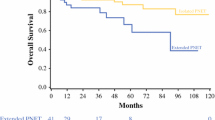Abstract. Between 1987 and 1996 a total of 25 patients with proved Zollinger-Ellison syndrome (ZES) have been treated in our department. If preoperative imaging studies did not show diffuse metastatic disease, patients were scheduled for operation with a standardized surgical approach including thorough exploration and intraoperative ultrasonography (IOUS) of the pancreas and a longitudinal duodenotomy, with separate palpation of the anterior and posterior walls. Postoperatively, patients were followed up by physical examination, fasting gastrin levels, and the secretin stimulation test. Altogether 10 patients had duodenal wall gastrinoma, 14 patients pancreatic gastrinoma, and the tumor was not found in 1 patient. Only 15 tumors (60%) (2 duodenal wall and 13 pancreatic gastrinomas) could be visualized preoperatively. Intraoperatively, 24 of 25 primary gastrinomas were localized. The mean size of duodenal wall gastrinomas (9.6 mm) was significantly smaller than that of pancreatic gastrinomas (28.7 mm) (
p < 0.05). At the time of surgical exploration, five duodenal and seven pancreatic gastrinomas had metastasized. The incidence of lymph node metastases was similar for both tumor sites, whereas patients with pancreatic gastrinomas more frequently had liver metastases. The presence of liver metastases was the most important determinant for survival. Four patients (40%) with duodenal and seven with pancreatic (50%) gastrinomas (mean follow-up 5.2 years) were biochemically cured by operation. Of the remaining patients, eight are still alive with recurrent disease. Our results suggest that preoperative localization of gastrinomas often fails despite all modern imaging methods. Therefore a standardized surgical exploration of the pancreas including IOUS and a duodenal exploration should be performed to achieve optimal results. Preoperative diagnostic imaging tests should include computed tomography, ultrasonography, and somatostatin receptor scintigraphy to exclude diffuse metastases. In contrast to liver metastases, lymph node metastases do not have a significant influence on survival.
Similar content being viewed by others
Author information
Authors and Affiliations
Rights and permissions
About this article
Cite this article
Kisker, O., Bastian, D., Bartsch, D. et al. Localization, Malignant Potential, and Surgical Management of Gastrinomas. World J. Surg. 22, 651–658 (1998). https://doi.org/10.1007/s002689900448
Issue Date:
DOI: https://doi.org/10.1007/s002689900448




